Potential of Stainless Steel Slag Waste in Manufacturing Self-Compacting Concrete
Abstract
1. Introduction
2. Materials Characterization and Dosage
2.1. Cement and Natural Aggregates (Aggregates, Sand and Filler)
2.2. Processed Stainless Steel Slag
2.3. Dosage
3. Testing Methods and Results
3.1. Flowability
3.2. Compressive Strength.
3.3. Tensile Splitting Strength
3.4. Shrinkage
3.5. Water Penetration under Pressure
3.6. Chloride Ion Penetration
3.7. Carbonation Depth
4. Conclusions
- -
- SSs present an elemental composition of SiO2, CaO and MgO. The mineralogy of the SSs showed high levels of merwinite, calcium oxide, magnesium, silica and akermanite (Ca-Mg-Si). The treatment of crushing and burning of SSs leads to an increase in SiO2 and CaO values, as well as a decrease in density and absorption.
- -
- The environmental study by means of leaching classifies SSs as non-hazardous material due to the high values of Cr. The burning treatment increases the leaching values of these elements, Se and Mo.
- -
- In relation to the mechanical properties for the SCC-30 series, the compressive strength of SCC manufactured with SSs decreases slightly with respect to the control. The burning and crushing treatment of the SSs improves the mechanical properties. In the SCC-50 series, higher compression values are obtained with the use of SSs. The treatment in this case leads to a reduction in the values.
- -
- In terms of durability parameters, SCC-30 has smaller dimensional changes than SCC-50 has. The use of SSs in the manufactured of SCC results in greater dimensional instability, especially when SSs are processed. In relation to chloride ion penetration, a reduction of this parameter can be observed in SCC manufactured with SSs as compared to control. The depth of carbonation is lower in SCC when SSs were subjected to crushing and combined crushing and burning processes.
Author Contributions
Funding
Acknowledgments
Conflicts of Interest
Appendix A
References
- Association, W.S. Steel Industry by-Products; Worldsteel Association: Brussels, Belgium, 2016. [Google Scholar]
- Peters, K.; Malfa, E.; Colla, V. The european steel technology platform's strategic research agenda: A further step for the steel as backbone of EU resource and energy intense industry sustainability. Metallurgia Ital. 2019, 5, 5–17. [Google Scholar]
- UNESID. Series históricas. Available online: https://unesid.org/datos-series-historicas.php (accessed on 25 April 2020).
- World Steel Association. Available online: https://www.worldsteel.org/media-centre/press-releases/2018/world-steel-in-figures-2018.html (accessed on 24 April 2020).
- Thomas, C.; Rosales, J.; Polanco, J.A.; Agrela, F. Steel slags. In New Trends in Eco-Efficient and Recycled Concretede; Brito, J., Agrela, F., Eds.; Woodhead Publishing: Cambridge, UK, 2019; pp. 169–190. ISBN 978-0-08-102480-5. [Google Scholar]
- Zhang, X.; Zhang, H.; He, P.; Shao, L.; Wang, R.; Chen, R. Beneficial reuse of stainless steel slag and its heavy metals pollution risk. Res. Environ. Sci. 2008, 21, 33–37. [Google Scholar]
- Rosales, J.; Cabrera, M.; Agrela, F. Effect of stainless steel slag waste as a replacement for cement in mortars. Mechanical and statistical study. Constr. Build. Mater. 2017, 142, 444–458. [Google Scholar] [CrossRef]
- Sheen, Y.-N.; Huang, L.-J.; Sun, T.-H.; Le, D.-H. Engineering properties of self-compacting concrete containing stainless steel slags. Procedia Eng. 2016, 142, 79–86. [Google Scholar] [CrossRef]
- Sheen, Y.-N.; Wang, H.-Y.; Sun, T.-H. Properties of green concrete containing stainless steel oxidizing slag resource materials. Constr. Build. Mater. 2014, 50, 22–27. [Google Scholar] [CrossRef]
- Felekoğlu, B.; Tosun, K.; Baradan, B.; Altun, A.; Uyulgan, B. The effect of fly ash and limestone fillers on the viscosity and compressive strength of self-compacting repair mortars. Cem. Concr. Res. 2006, 36, 1719–1726. [Google Scholar] [CrossRef]
- Türkmen, İ. Influence of different curing conditions on the physical and mechanical properties of concretes with admixtures of silica fume and blast furnace slag. Mater. Lett. 2003, 57, 4560–4569. [Google Scholar] [CrossRef]
- Binici, H.; Kaplan, H.; Yilmaz, S. Influence of marble and limestone dusts as additives on some mechanical properties of concrete. Sci. Res. Essay 2007, 2, 372–379. [Google Scholar]
- Corinaldesi, V.; Moriconi, G.; Naik, T.R. Characterization of marble powder for its use in mortar and concrete. Constr. Build. Mater. 2010, 24, 113–117. [Google Scholar] [CrossRef]
- Uygunoğlu, T.; Topçu, İ.B.; Çelik, A.G. Use of waste marble and recycled aggregates in self-compacting concrete for environmental sustainability. J. Clean. Prod. 2014, 84, 691–700. [Google Scholar] [CrossRef]
- Valdez, P.; Barragán, B.; Girbes, I.; Shuttleworth, N.; Cockburn, A. Use of waste from the marble industry as filler for the production of self-compacting concretes. Mater. Construcción 2011, 61, 61–76. [Google Scholar]
- Hossain, K.; Lachemi, M. Fresh, mechanical, and durability characteristics of self-consolidating concrete incorporating volcanic ash. J. Mater. Civ. Eng. 2010, 22, 651–657. [Google Scholar] [CrossRef]
- Anastasiou, E.K.; Papayianni, I.; Papachristoforou, M. Behavior of self compacting concrete containing ladle furnace slag and steel fiber reinforcement. Mater. Des. 2014, 59, 454–460. [Google Scholar] [CrossRef]
- Tomasiello, S.; Felitti, M. EAF slag in self-compacting concretes. Facta Univ.-Ser. Archit. Civ. Eng. 2010, 8, 13–21. [Google Scholar] [CrossRef]
- Sheen, Y.-N.; Le, D.-H.; Sun, T.-H. Innovative usages of stainless steel slags in developing self-compacting concrete. Constr. Build. Mater. 2015, 101, 268–276. [Google Scholar] [CrossRef]
- Sideris, K.K.; Tassos, C.; Chatzopoulos, A. Production of durable self-compacting concrete using ladle furnace slag (LFS) as filler material. Procedia Eng. 2015, 108, 592–597. [Google Scholar] [CrossRef]
- Bertolini, L.; Elsener, B.; Pedeferri, P.; Redaelli, E.; Polder, R. Corrosion of Steel in Concrete; Wiley-Vch: Weinheim, Germany, 2013; Volume 392. [Google Scholar]
- Tossavainen, M.; Engstrom, F.; Yang, Q.; Menad, N.; Larsson, M.L.; Bjorkman, B. Characteristics of steel slag under different cooling conditions. Waste Manag. 2007, 27, 1335–1344. [Google Scholar] [CrossRef]
- Rondi, L.; Bregoli, G.; Sorlini, S.; Cominoli, L.; Collivignarelli, C.; Plizzari, G. Concrete with EAF steel slag as aggregate: A comprehensive technical and environmental characterisation. Compos. Part B Eng. 2016, 90, 195–202. [Google Scholar] [CrossRef]
- Naik, T.R.; Kumar, R.; Ramme, B.W.; Canpolat, F. Development of high-strength, economical self-consolidating concrete. Constr. Build. Mater. 2012, 30, 463–469. [Google Scholar] [CrossRef]
- Uysal, M. Self-compacting concrete incorporating filler additives: Performance at high temperatures. Constr. Build. Mater. 2012, 26, 701–706. [Google Scholar] [CrossRef]
- Boukendakdji, O.; Kenai, S.; Kadri, E.; Rouis, F. Effect of slag on the rheology of fresh self-compacted concrete. Constr. Build. Mater. 2009, 23, 2593–2598. [Google Scholar] [CrossRef]
- Pereira, P.; Evangelista, L.; De Brito, J. The effect of superplasticizers on the mechanical performance of concrete made with fine recycled concrete aggregates. Cem. Concr. Compos. 2012, 34, 1044–1052. [Google Scholar] [CrossRef]
- Holschemacher, K.; Klug, Y. A database for the evaluation of hardened properties of SCC. Lacer 2002, 7, 124–134. [Google Scholar]
- Saak, A.W.; Jennings, H.M.; Shah, S.P. New methodology for designing self-compacting concrete. Mater. J. 2001, 98, 429–439. [Google Scholar]
- Sua-iam, G.; Makul, N. Utilization of high volumes of unprocessed lignite-coal fly ash and rice husk ash in self-consolidating concrete. J. Clean. Prod. 2014, 78, 184–194. [Google Scholar] [CrossRef]
- Corinaldesi, V.; Moriconi, G. The role of industrial by-products in self-compacting concrete. Constr. Build. Mater. 2011, 25, 3181–3186. [Google Scholar] [CrossRef]
- Corinaldesi, V.; Moriconi, G. Influence of mineral additions on the performance of 100% recycled aggregate concrete. Constr. Build. Mater. 2009, 23, 2869–2876. [Google Scholar] [CrossRef]
- Kou, S.; Poon, C. Properties of self-compacting concrete prepared with coarse and fine recycled concrete aggregates. Cem. Concr. Compos. 2009, 31, 622–627. [Google Scholar] [CrossRef]
- Tiwari, A.; Singh, S.; Nagar, R. Feasibility assessment for partial replacement of fine aggregate to attain cleaner production perspective in concrete: A review. J. Clean. Prod. 2016, 135, 490–507. [Google Scholar] [CrossRef]
- Aslani, F.; Ma, G.; Yim Wan, D.L.; Muselin, G. Development of high-performance self-compacting concrete using waste recycled concrete aggregates and rubber granules. J. Clean. Prod. 2018, 182, 553–566. [Google Scholar] [CrossRef]
- Ibrahim, M.H.W.; Hamzah, A.F.; Jamaluddin, N.; Ramadhansyah, P.J.; Fadzil, A.M. Split tensile strength on self-compacting concrete containing coal bottom ash. Procedia-Soc. Behav. Sci. 2015, 195, 2280–2289. [Google Scholar] [CrossRef][Green Version]
- Instrucción del Hormigón Estructural, I EHE-08. Madrid, Ministerio de Fomento, Secretaría General Técnica 2008. Available online: https://www.mitma.gob.es/recursos_mfom/capituloviiiborde.pdf (accessed on 25 April 2020).
- Poppe, A.M.; De Schutter, G. Creep and shrinkage of self-compacting concrete. In Proceedings of the First International Symposium on Design, Performance and Use of Self-Consolidating Concrete, Changsha China, 26–28 May 2005; pp. 329–336. [Google Scholar]
- Wassermann, R.; Katz, A.; Bentur, A. Minimum cement content requirements: A must or a myth? Mater. Struct. 2009, 42, 973–982. [Google Scholar] [CrossRef]
- Song, H.; Byun, K.; Kim, S.; Choi, D. Early-age creep and shrinkage in self-compacting concrete incorporating GGBFS. Proceedings of The Second International Symposium on Self-Compacting Concrete; Song, H.; Byun, K.; Kim, S.; Choi, D. COMS Engineering Corporation: Tokyo, Japan, October 2001; pp. 413–422. ISBN 4-90154-04-0. [Google Scholar]
- Dinakar, P.; Reddy, M.K.; Sharma, M. Behaviour of self compacting concrete using Portland pozzolana cement with different levels of fly ash. Mater. Des. 2013, 46, 609–616. [Google Scholar] [CrossRef]
- Da Silva, P.; De Brito, J. Experimental study of the porosity and microstructure of self-compacting concrete (SCC) with binary and ternary mixes of fly ash and limestone filler. Constr. Build. Mater. 2015, 86, 101–112. [Google Scholar] [CrossRef]
- Abidin, Z.; Ernida, N.; Wan Ibrahim, M.H.; Jamaluddin, N.; Kamaruddin, K.; Hamzah, A.F. The effect of bottom ash on fresh characteristic, compressive strength and water absorption of self-compacting concrete. Appl. Mech. Mater. 2014, 660, 145–151. [Google Scholar] [CrossRef]
- Siddique, R. Compressive strength, water absorption, sorptivity, abrasion resistance and permeability of self-compacting concrete containing coal bottom ash. Constr. Build. Mater. 2013, 47, 1444–1450. [Google Scholar] [CrossRef]
- El Mir, A.; Nehme, S.G. Utilization of industrial waste perlite powder in self-compacting concrete. J. Clean. Prod. 2017, 156, 507–517. [Google Scholar] [CrossRef]
- Hassan, A.A.; Lachemi, M.; Hossain, K.M. Effect of metakaolin and silica fume on the durability of self-consolidating concrete. Cem. Concr. Compos. 2012, 34, 801–807. [Google Scholar] [CrossRef]
- Celik, K.; Meral, C.; Mancio, M.; Mehta, P.K.; Monteiro, P.J. A comparative study of self-consolidating concretes incorporating high-volume natural pozzolan or high-volume fly ash. Constr. Build. Mater. 2014, 67, 14–19. [Google Scholar] [CrossRef]
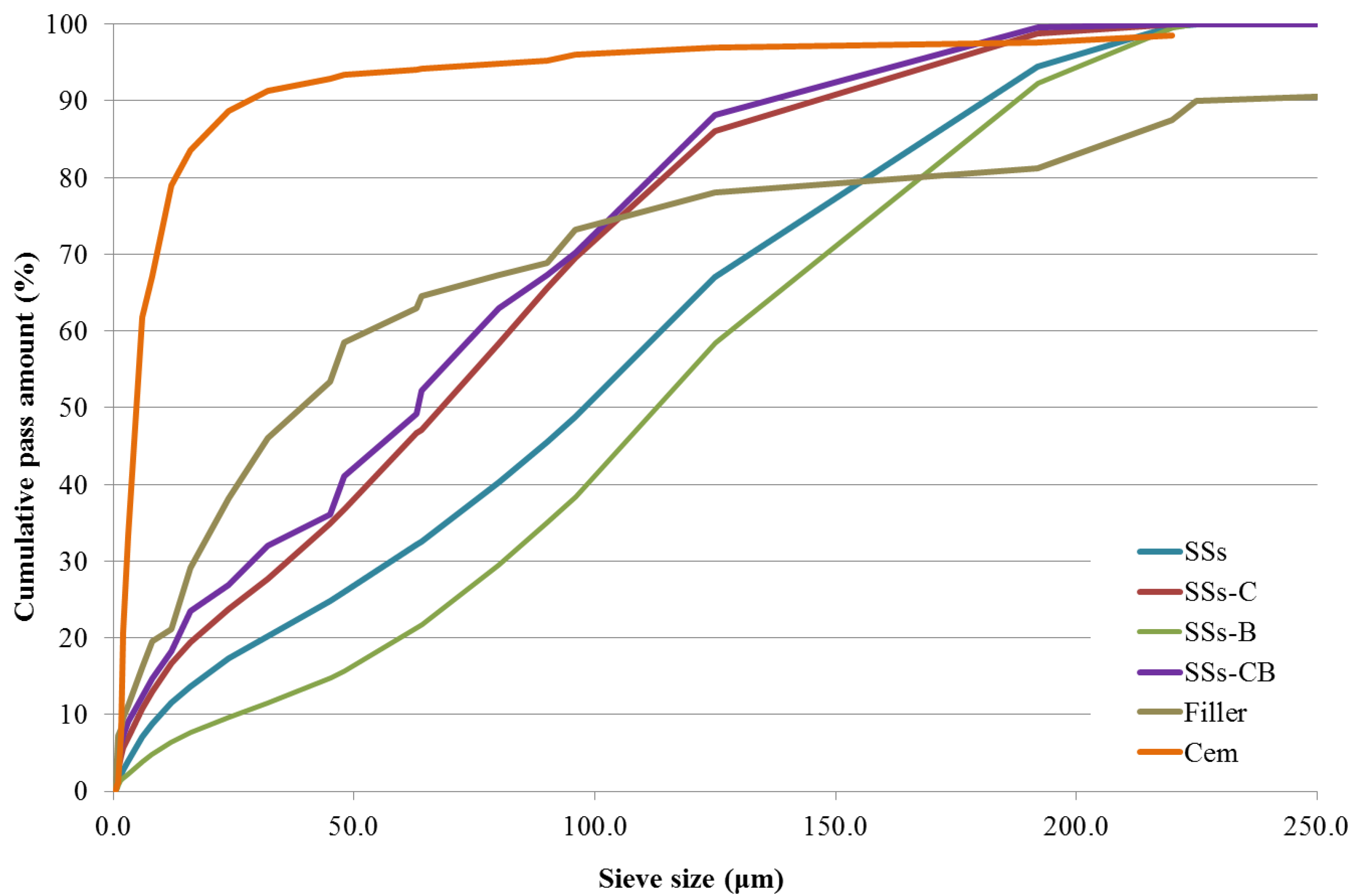

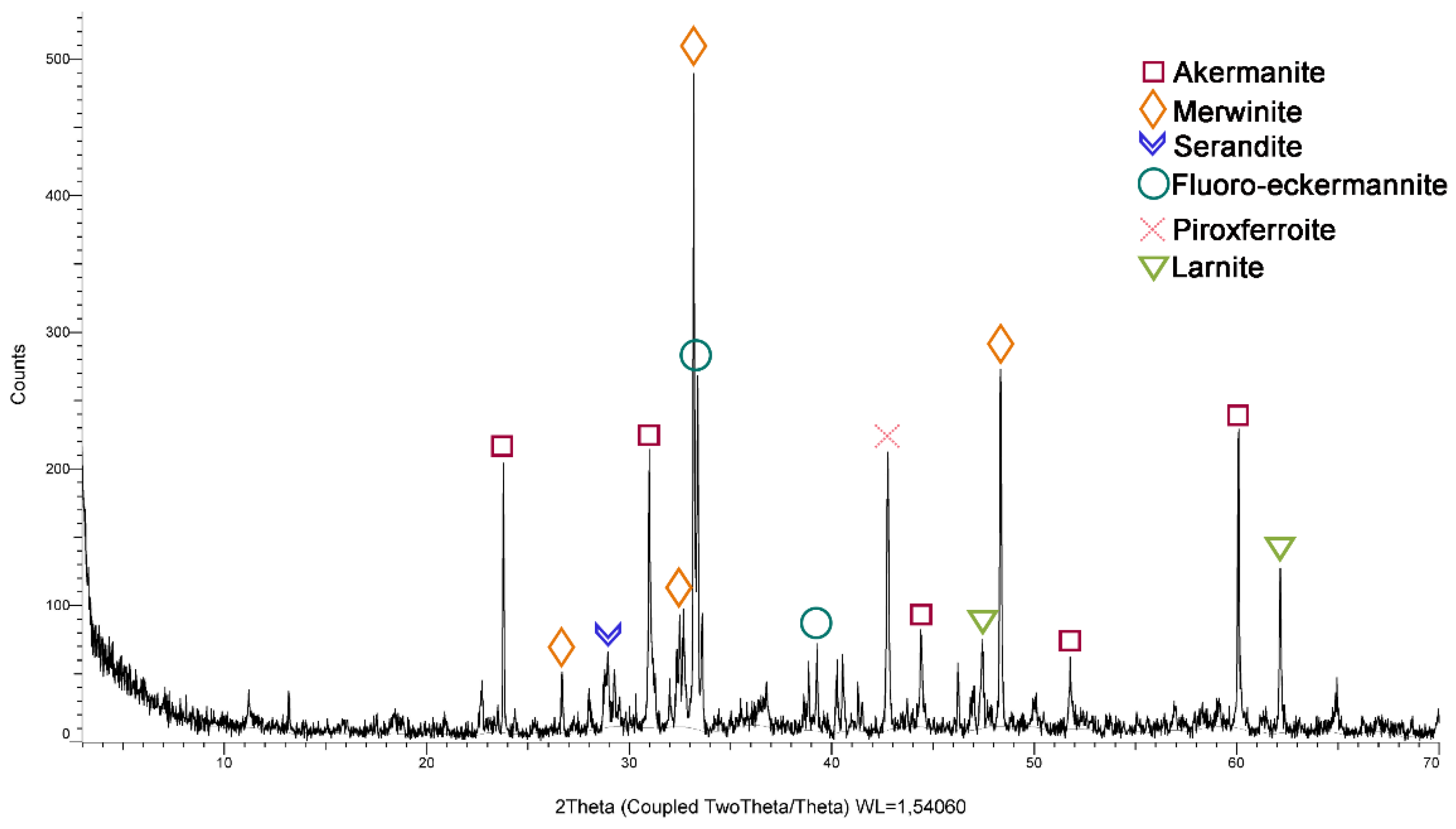

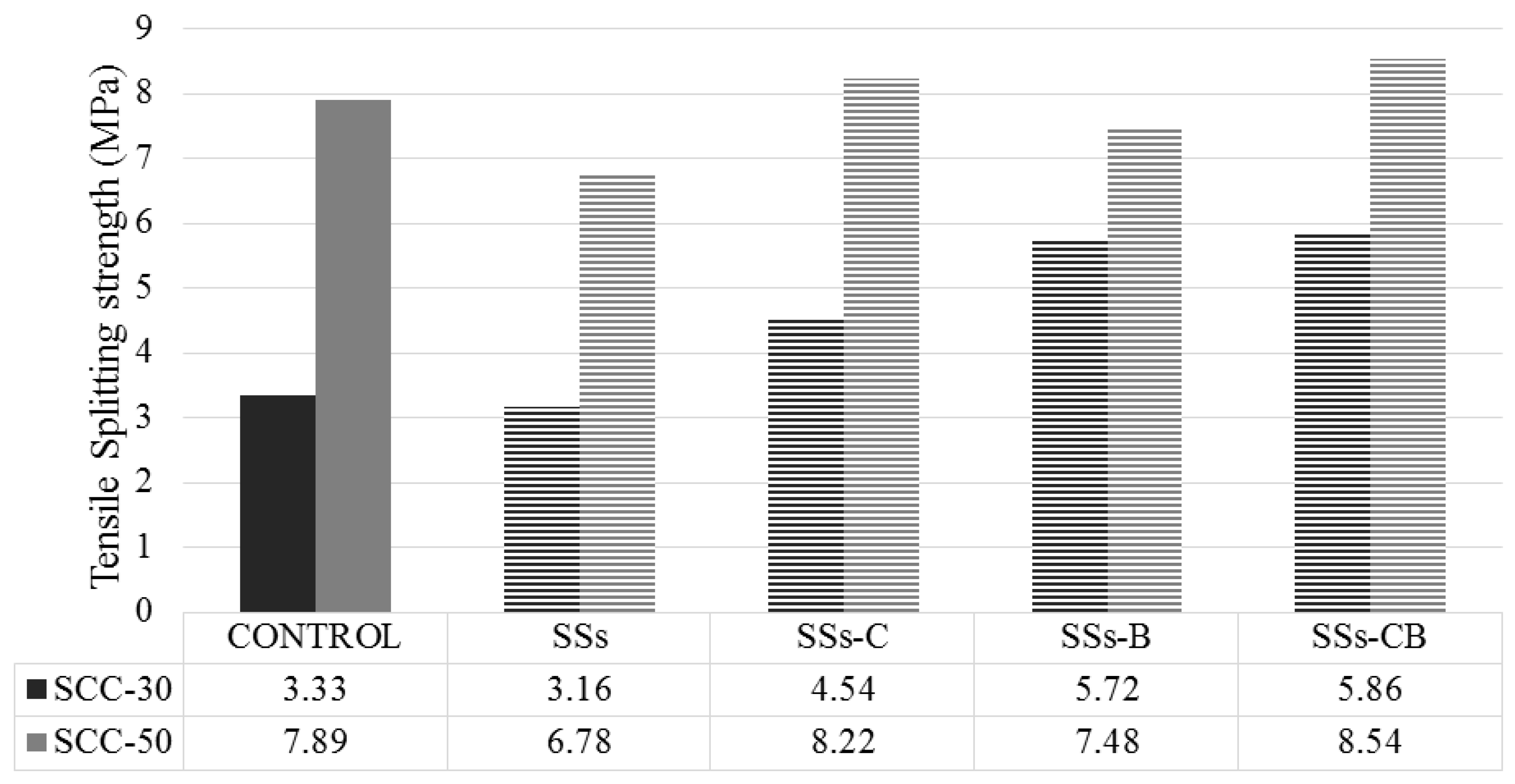


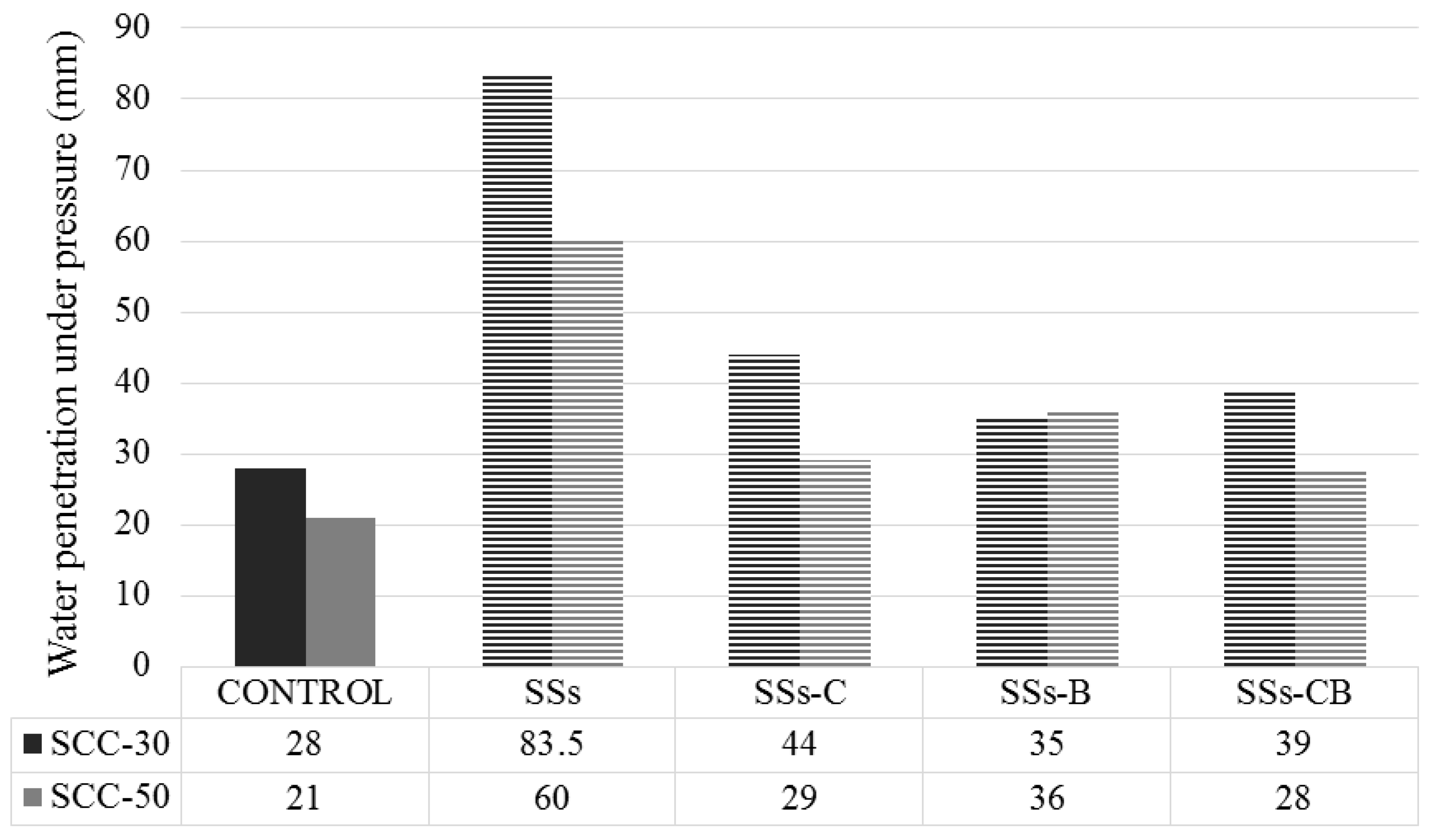

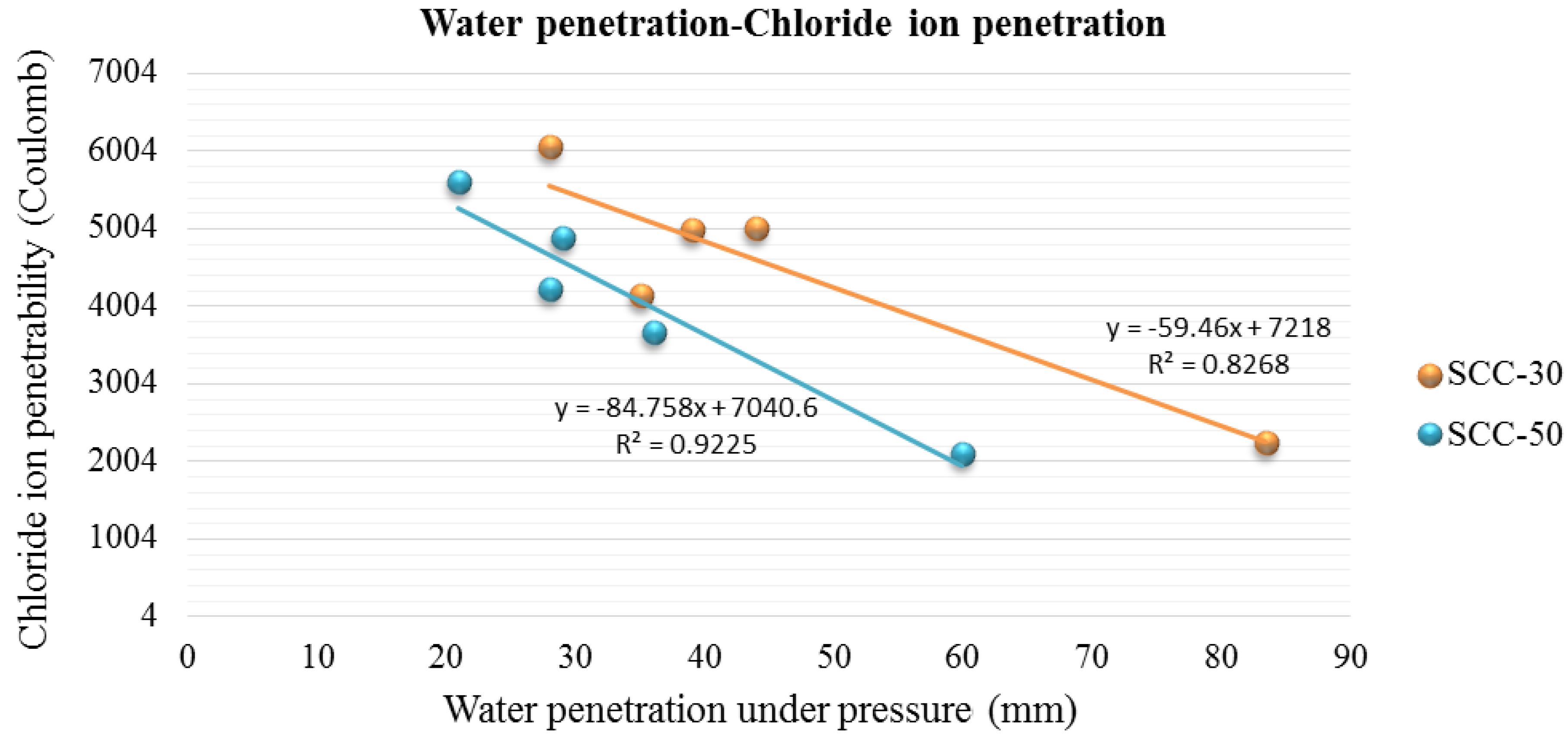


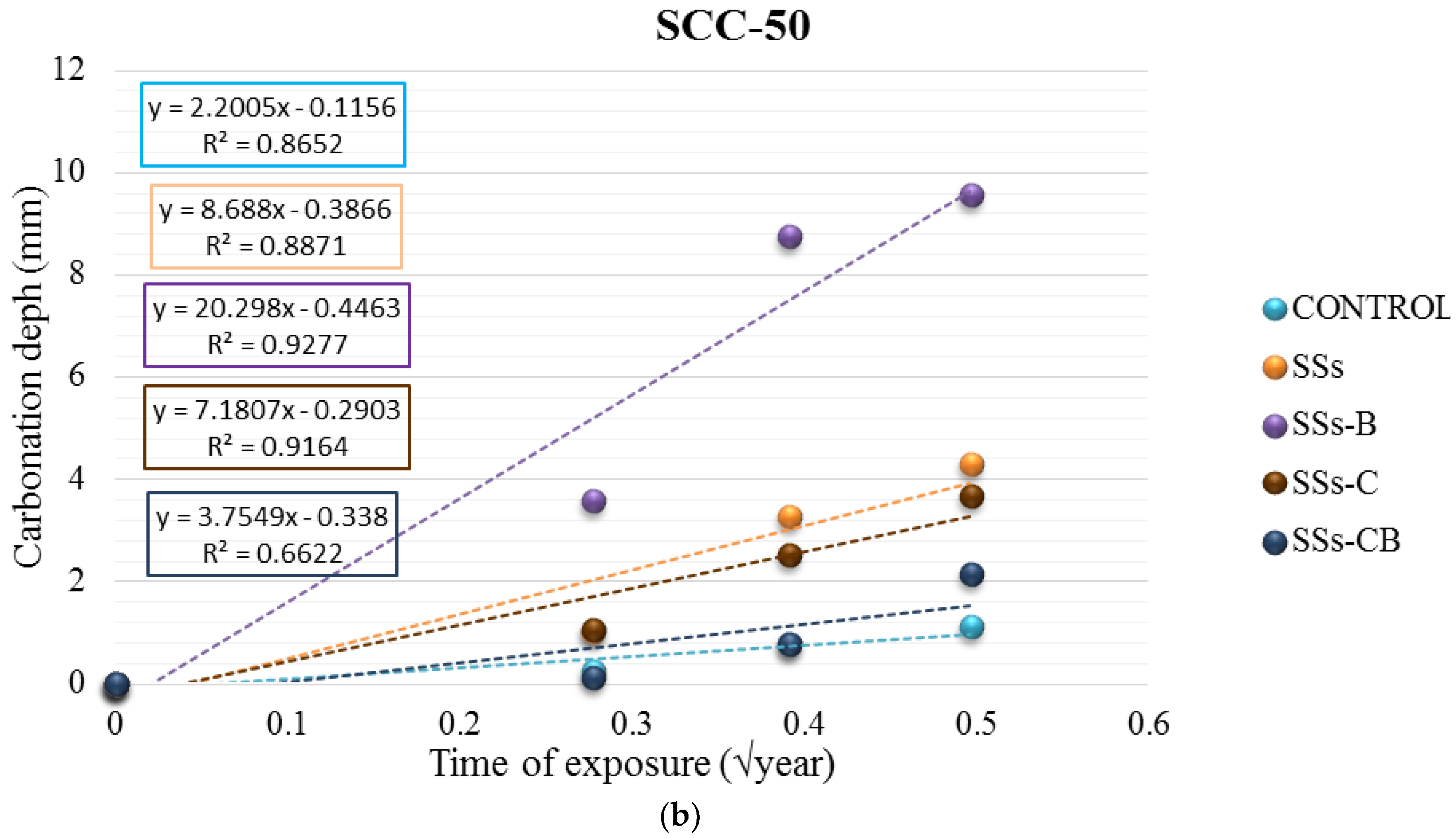
| SSs | SSs-C | SSs-B | SSs-CB | Test Method | ||
|---|---|---|---|---|---|---|
| Physical Properties | - | - | - | |||
| Density-SSD (kg/dm3) | 2.06 | 1.8 | 1.69 | 1.66 | UNE - EN 1097-6:2014 | |
| Absorption (%) | 6.12 | 5.31 | 5.44 | 5.41 | ||
| Chemical Properties | - | - | - | |||
| Elemental Content (%) | SiO2 | 28.30 | 29.88 | 29.04 | 30.59 | UNE-EN 196-2:2014 |
| Al2O3 | 5.64 | 5.73 | 5.64 | 5.86 | ||
| Fe2O3 | 3.09 | 1.31 | 2.30 | 1.17 | ||
| CaO | 42.09 | 44.51 | 43.11 | 44.73 | ||
| MgO | 10.97 | 11.68 | 11.22 | 11.63 | ||
| SO3 | 0.39 | 0.34 | 0.33 | 0.35 | ||
| Water-Soluble Chlorides (%) | 0.025 | 0.017 | 0.016 | 0.02 | UNE-EN 1744-1:2010 | |
| Inert Limit - Non-Hazardous (mg/kg M.S.) | SSs | SSs-C | SSs-B | SSs-CB | |
|---|---|---|---|---|---|
| (mg/kg) | (mg/kg) | (mg/kg) | (mg/kg) | ||
| Cr | 0.5–10 | 2.356 | 1.328 | 6.568 | 2.190 |
| Ni | 0.4–10 | 0 | 0 | 0 | 0 |
| Cu | 2–50 | 0 | 0 | 0 | 0 |
| Zn | 4–50 | 0.003 | 0 | 0 | 0 |
| As | 0.5–2 | 0.002 | 0 | 0 | 0 |
| Se | 0.1–0.5 | 0.097 | 0.089 | 0.171 | 0.048 |
| Mo | 0.5–10 | 0.463 | 0.486 | 1.602 | 0.288 |
| Cd | 0.04–1 | 0 | 0 | 0 | 0 |
| Sb | 0.06–0.7 | 0.017 | 0.001 | 0.001 | 0.001 |
| Ba | 20–100 | 1.776 | 0.294 | 7.790 | 6.642 |
| Hg | 0.01–0.2 | 0 | 0 | 0 | 0 |
| Pb | 0.5–10 | 0 | 0 | 0 | 0 |
| Sand | Aggregates | Cement | Filler | Additive | Water | W/C Relation | SSs | |||||
|---|---|---|---|---|---|---|---|---|---|---|---|---|
| (0–4 mm) | (4–200 mm) | - | - | - | - | - | SSs | SSs-C | SSs-B | SSs-CB | ||
| SCC-30 | SCC-30-Control | 1000 | 700 | 325 | 125 | 3.41 | 195 | 0.60 | - | - | - | - |
| SCC-30-SSs | 1000 | 700 | 330 | - | 3.3 | 210 | 0.64 | 115 | - | - | - | |
| SCC-30-SSs-C | 1000 | 700 | 325 | - | 3.25 | 205 | 0.63 | - | 125 | - | - | |
| SCC-30-SSs-B | 1000 | 700 | 325 | - | 3.25 | 205 | 0.63 | - | - | 125 | - | |
| SCC-30-SSs-CB | 1000 | 700 | 325 | - | 3.25 | 205 | 0.63 | - | - | - | 125 | |
| SCC-30 50/50 | SCC-30-0.5SSs | 1000 | 700 | 330 | 63 | 3.30 | 201 | 0.61 | 58 | - | - | - |
| SCC-30-0.5SSs-C | 1000 | 700 | 325 | 63 | 3.25 | 198 | 0.61 | - | 63 | - | - | |
| SCC-30-0.5SSs-B | 1000 | 700 | 325 | 63 | 3.25 | 198 | 0.61 | - | - | 63 | - | |
| SCC-30-0.5SSs-CB | 1000 | 700 | 325 | 63 | 3.25 | 198 | 0.61 | - | - | - | 63 | |
| SCC-50 | SCC-50-Control | 1000 | 700 | 450 | 20 | 4.95 | 180 | 0.40 | - | - | - | - |
| SCC-50-SSs | 1000 | 700 | 450 | - | 4.90 | 185 | 0.41 | 20 | - | - | - | |
| SCC50-SSs-C | 1000 | 700 | 450 | - | 4.90 | 185 | 0.41 | - | 20 | - | - | |
| SCC50-SSs-B | 1000 | 700 | 450 | - | 4.90 | 185 | 0.41 | - | - | 20 | ||
| SCC50-SSs-CB | 1000 | 700 | 450 | - | 4.90 | 185 | 0.41 | - | - | - | 20 | |
| Test Method | Curing Time | ||
|---|---|---|---|
| Technological tests | Properties of Fresh SCC | - | - |
| Flowability | UNE-EN 12350-8:2011 UNE-EN 12350-10:2011 UNE 12350-12:2011 | 0 days | |
| Properties of Hardened SCC | - | - | |
| Compressive strength | UNE 12390-3:2009 | 1, 7, 28, 56, 90 days | |
| Tensile splitting strength | UNE-EN 12390-6:2010 | 28 days | |
| Shrinkage | ASTM C157-17 | 1, 14, 28, 56, 90 days | |
| Durability properties | Water penetration under pressure | UNE 12390-8:2009 | 28 days |
| Chloride Ion Penetration | ASTM C1202-97 | 28 days | |
| Depth carbonation | UNE 112011:2011 | 28, 56, 90 days |
| Slump Test | L-Box Test | J-Ring | ||||
|---|---|---|---|---|---|---|
| D (mm) | T200 (s) | T400 (s) | H2/H1 (%) | DH = H1 − H2 (mm) | ||
| Compliance Requirements | 650–750 | <1.5 | <2.5 | 0.8–1 | <10 | |
| (Recommended) | ||||||
| SCC-30 | SCC-30-Control | 712 | 1.23 | 1.97 | 0.88 | 5.1 |
| SCC-30-SSs | 706 | 1.12 | 1.86 | 0.87 | 4.3 | |
| SCC-30-SSs-C | 725 | 1.67 | 2.13 | 0.91 | 4.2 | |
| SCC-30-SSs-B | 718 | 1.56 | 2.01 | 0.89 | 4.1 | |
| SCC-30-SSs-CB | 719 | 1.64 | 2.08 | 0.89 | 4.1 | |
| SCC-30 50/50 | SCC-30-0.5SSs | 711 | 1.33 | 2.25 | 0.87 | 5.02 |
| SCC-30-0.5SSs-C | 719 | 1.93 | 2.01 | 0.91 | 4.7 | |
| SCC-30-0.5SSs-B | 703 | 1.21 | 2.14 | 0.87 | 4.6 | |
| SCC-30-0.5SSs-CB | 716 | 1.38 | 2.23 | 0.9 | 4.6 | |
| SCC-50 | SCC-50-Control | 726 | 2.05 | 1.98 | 0.91 | 4.5 |
| SCC-50-SSs | 732 | 2.11 | 2.29 | 0.91 | 4.01 | |
| SCC50-SSs-C | 748 | 2.21 | 2.36 | 0.93 | 3.9 | |
| SCC50-SSs-B | 744 | 2.13 | 2.33 | 0.93 | 4.1 | |
| SCC50-SSs-CB | 741 | 2.18 | 2.44 | 0.92 | 4.2 | |
| Compressive Strength (MPa) | ||||||
|---|---|---|---|---|---|---|
| Days | ||||||
| 1 | 7 | 28 | 56 | 90 | ||
| SCC-30 | SCC-30-Control | 8.39 | 25.86 | 42.21 | 42.36 | 46.55 |
| SCC-30-SSs | 5.12 | 21.89 | 38.05 | 41.03 | 42.54 | |
| SCC-30-SSs-C | 9.48 | 26.08 | 41.03 | 42.15 | 43.21 | |
| SCC-30-SSs-B | 10.04 | 28.52 | 41.29 | 43.28 | 44.36 | |
| SCC-30-SSs-CB | 9.81 | 24.15 | 40.81 | 41.35 | 42.77 | |
| SCC-30 50/50 | SCC-30-0.5SSs | 10.12 | 29.15 | 44.68 | 45.28 | 47.44 |
| SCC-30-0.5SSs-C | 9.15 | 29.66 | 43.28 | 47.16 | 48.56 | |
| SCC-30-0.5SSs-B | 8.66 | 27.38 | 41.85 | 43.06 | 44.73 | |
| SCC-30-0.5SSs-CB | 9.12 | 30.06 | 44.12 | 48.27 | 48.98 | |
| SCC-50 | SCC-50-Control | 18.39 | 53.38 | 63.14 | 65.26 | 66.87 |
| SCC-50-SSs | 19.85 | 44.25 | 61.69 | 64.11 | 65.28 | |
| SCC50-SSs-C | 21.02 | 58.3 | 65.83 | 68.91 | 69.33 | |
| SCC50-SSs-B | 20.35 | 46.24 | 62.38 | 65.87 | 67.05 | |
| SCC50-SSs-CB | 23.87 | 61.79 | 66.22 | 69.06 | 70.15 | |
© 2020 by the authors. Licensee MDPI, Basel, Switzerland. This article is an open access article distributed under the terms and conditions of the Creative Commons Attribution (CC BY) license (http://creativecommons.org/licenses/by/4.0/).
Share and Cite
Rosales, J.; Agrela, F.; Entrenas, J.A.; Cabrera, M. Potential of Stainless Steel Slag Waste in Manufacturing Self-Compacting Concrete. Materials 2020, 13, 2049. https://doi.org/10.3390/ma13092049
Rosales J, Agrela F, Entrenas JA, Cabrera M. Potential of Stainless Steel Slag Waste in Manufacturing Self-Compacting Concrete. Materials. 2020; 13(9):2049. https://doi.org/10.3390/ma13092049
Chicago/Turabian StyleRosales, Julia, Francisco Agrela, José Antonio Entrenas, and Manuel Cabrera. 2020. "Potential of Stainless Steel Slag Waste in Manufacturing Self-Compacting Concrete" Materials 13, no. 9: 2049. https://doi.org/10.3390/ma13092049
APA StyleRosales, J., Agrela, F., Entrenas, J. A., & Cabrera, M. (2020). Potential of Stainless Steel Slag Waste in Manufacturing Self-Compacting Concrete. Materials, 13(9), 2049. https://doi.org/10.3390/ma13092049







